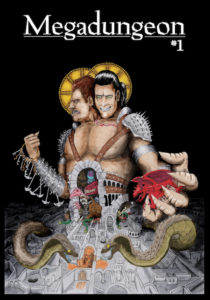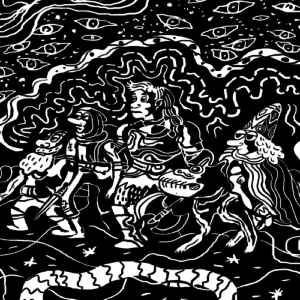(Being a review of Megadungeon #1, among other things.)
Since rediscovering fantasy roleplaying games sometime around 2011, I have followed the development of several home brew megadungeons. Some of my favorites include the taking-OD&D-seriously Dwimmermount, the Lovecraft-by-way-of-Vikings Black City, the Diablo-infused “precious shithole hellscape” Nightwick Abbey, the steam-age demonic fantasy cruise-ship-as-megadungeon HMS Apollyon, and the gleeful toybox-filled deity-haunted dungeon Numenhalla. These projects remain mostly unpublished1, present only as referee-musings, map-fragments, or, travelogue-style, as scattered session reports.
Numenhalla, however, is finally seeing (gradual) publication in the recent Hack & Slash zine Megadungeon, of which two issues are available as of this writing. This post considers Megadungeon #1, which contains a mix of referee advice, setting glimpses, some player-facing rules, and a couple intro dungeon areas. First, I will cover what I consider weaknesses, along with a few observations. Then, I will cover strengths and the promise Megadungeon (the zine) has for the practice of developing megadungeons for play.
The presentation has several weaknesses, the primary being transitions. Many of the sections began life as a blog posts, and it shows. This is only a minor flaw; in some ways, it even adds to the utility, creating a series of self-contained easy to reference nuggets, but it also makes the whole feel more like a grab bag than a carefully designed book. The amount of actual dungeon content in this issue is also rather small. While the two dungeon areas are wonderfully evocative, with beautifully hand-illustrated maps, they are also somewhat linear and detail only 15 keyed areas (dungeon content arguably occupies 5 of the 38-some zine pages). While I think it is a common mistake to attempt keying a giant sprawl of rooms when starting a megadungeon, rather than working with a more tractable map, I was still hoping for a bit more. That said, the creativity of the areas makes up somewhat for the quantity, and I realize that issue one also may involve more setting and play advice groundwork compared to future issues.
The biggest strength, apart from the obvious enthusiasm, is the art, which projects a sense of playfulness that is too often lacking in fantasy art. However, the playfulness never descends into explicit goofiness or self-deprecation, and at some points almost verges into a sense of the mystic (a good thing when attempting to capture the fantastic). The dungeon features themselves are often weighted with promise (see the pitch black door, for example). I have less to say about the various rules bits, such as the augatic class (a tin man style robot that gains new powers through upgrades), but they are well done and easy enough to drop into any game using a B/X type engine.
Though the last handful of years has produced several notable published megadungeons2, such as Stonehell, Barrowmaze, Castle Gargantua, and Maze of the Blue Medusa, I would still like to see more experimentation in different ways to present a megadungeon for direct use by someone that is not the dungeon’s author. To my knowledge, no existing megadungeon has used a zine format so I am curious to see where Courtney takes this. The closest approach I am aware of is the collaborative darkness beneath megadungeon published in the now-defunct Fight On!. Though there were a few standout levels, such as Sham’s level 2 and level 3, it suffered overall from a lack of coherent vision.
The zine format encourages zone-level publication, which naturally breaks down the task into more achievable units. While this might be less of a concern for Numenhalla, as I gather a large portion of the dungeon is already designed, it would probably be a good approach for any referee who wants to share their megadungeon. The major challenge using this form is that a good dungeon contains relationships between various areas, and this is difficult to pull off if one creates and publishes areas in sequences. How does one include a well-considered gate to level 5 in level 1 if level 5 is as yet undefined? Notably, the Numenhalla entrance halls do contain several (locked) connections to deeper areas, but we will need to wait for future issues to see if the dungeon can make good on this promise.
Anyone interested in the idea of megadungeon play would probably get something out of this zine. As the text states:
All mounts and valleys,
And all lands.
As a disclaimer, I have gamed with Courtney both as player and referee.
Purchase info
- Date: 2017-12-19
- Price: $12.85 + $1.16 (local tax) + $5.32 (shipping) = $19.33 CAD
- Details: RPGNow print on demand + PDF
See here for my approach to reviews and why I share this purchase info.
1. The ACKS-published extrapolation of Dwimmermount is the closest to publication for any of these dungeons, but ultimately completes a different project than the original idea behind Dwimmermount. ↩
2. I make no attempt here to offer a comprehensive list of recent megadungeons, but the ones I listed stand out as attempts to push the form in various ways. ↩


